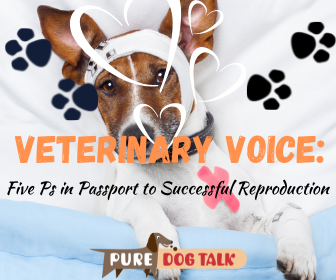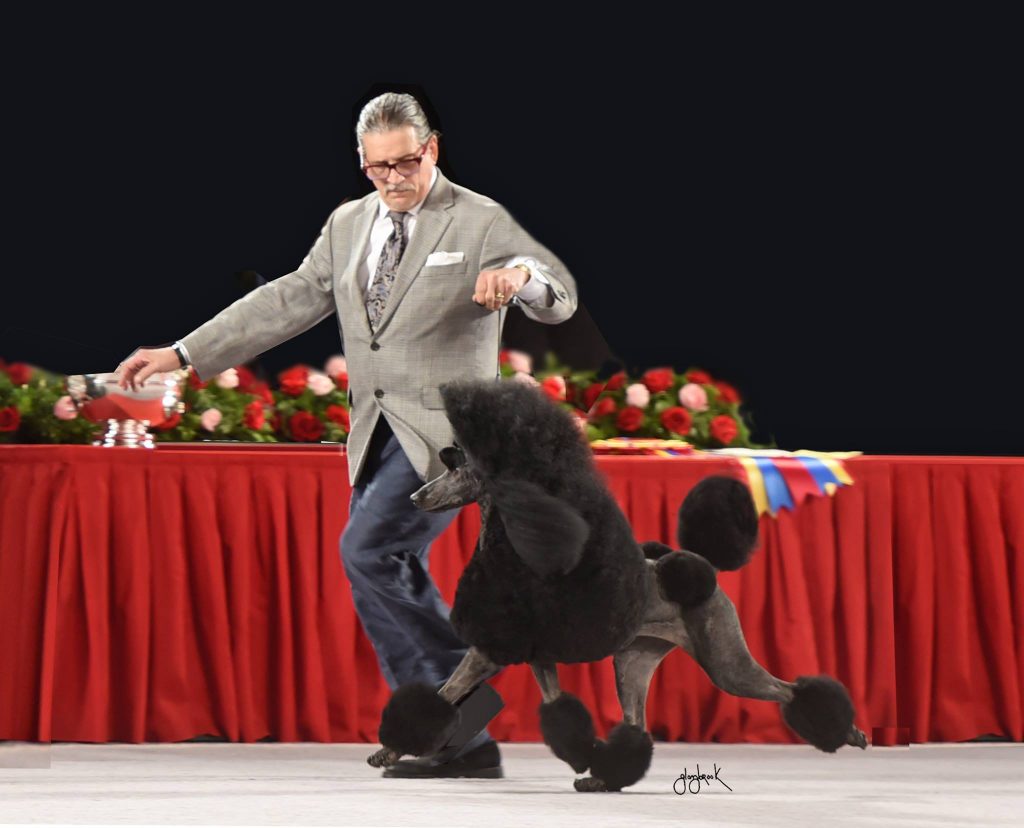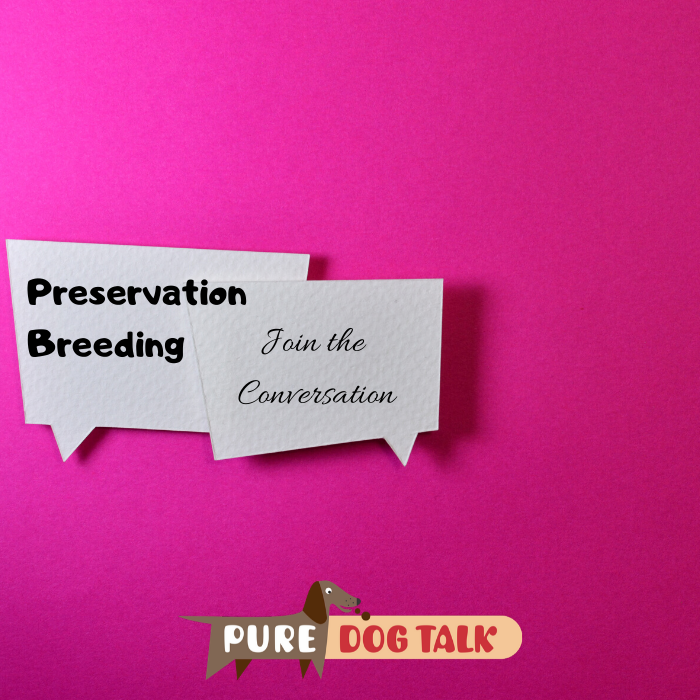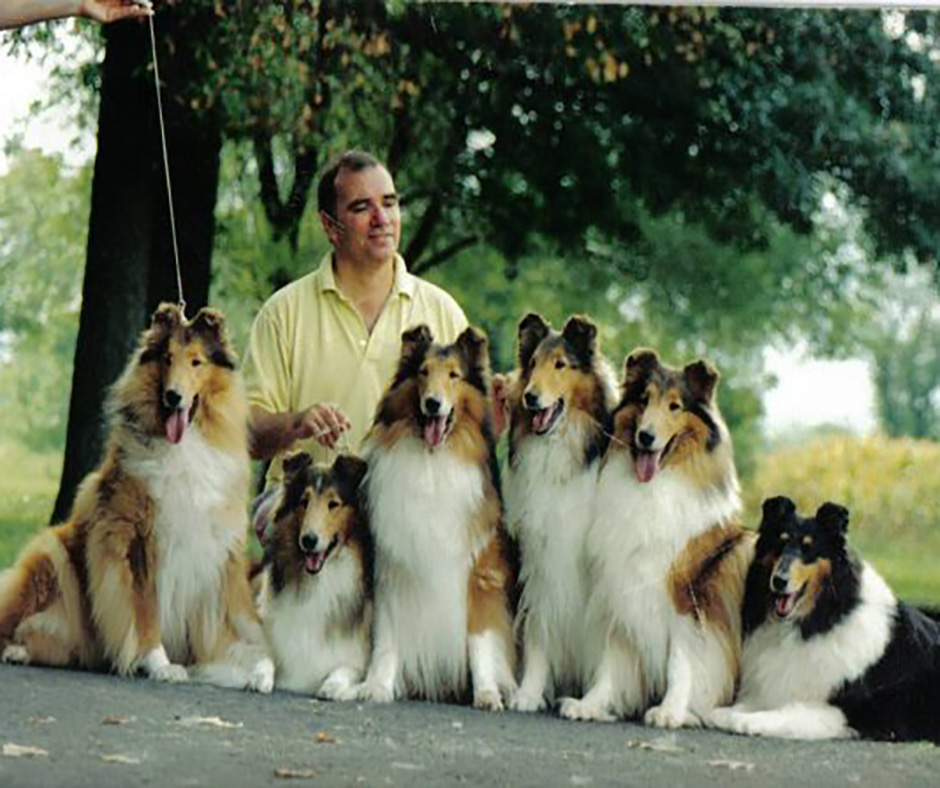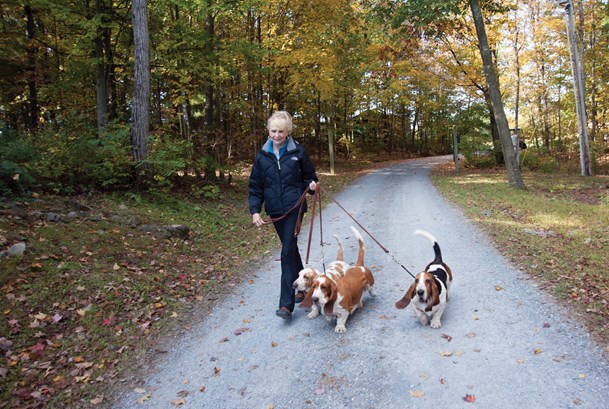484 – Five Ps in Passport to Successful Reproduction
Five Ps in Passport to Successful Reproduction
Dr. Marty Greer, DVM, joins host Laura Reeves to discuss the five Ps in the passport to successful dog breeding.
Progesterone
“We need to start progesterone testing early enough and repeating the testing often enough and long enough to make sure that she’s ovulate plus one test beyond that. So ovulation in most people’s labs is going to be between four and eight nanograms per mil.
“Be sure you start early enough and you go long enough that you’ve got one progesterone past five. If you stop at 4.7 and then she doesn’t get pregnant, we don’t know if she actually did or not (ovulate)… It’s not only to get the breeding done successfully, it’s also so that you can time when she’s doing to whelp.
“I cannot overemphasize the importance of progesterone timing. If nothing else, you’re going to have the vet clinic on your side when you call, (instead of) saying, ‘Well, really I have no idea when she’s actually due.’ I don’t know if you’re overstating the crisis that you’re in, if you’re underestimating the crisis you’re in, but without that data we really, as a veterinary community, don’t have the information we need to start initiating early care to save your bitch to save your litter.
Prenatal Care
“We know from the human side how important good prenatal care is. There’s a reason that women that are pregnant go to the doctor frequently. We need to monitor the bitch during prenatal care but even before she gets pregnant, we need to start folic acid 6 to 8 weeks before she comes into heat. We need to have her in an ideal body condition. We need to make sure she’s on an appropriate diet that doesn’t contain legumes, peas and beans. And we need to make sure she’s on a diet that’s got the macro and micro nutrients that she’s going to need to be pregnant and sustain a pregnancy.
“We want to make sure vaccines are up to date, because you can’t vaccinate during pregnancy and if she comes due during the time she’s pregnant, we cannot vaccinate. We want to make sure she’s an appropriate heartworm and flea and tick preventives that are safe for breeding dogs.
“We want to make sure that we’ve brucellosis tested her well enough in advance that if she comes back positive we can do the confirmatory test, because up to 10% of the brucellosis test will come back positive, and that can be a false positive. Now, that being said, it’s easy to say ‘Oh yeah, brucellosis doesn’t happen in the United states anymore.’ And guess what that’s not true.
Puppy Count X-ray
“Take the X-ray somewhere between day 55 and a 60 of her pregnancy.
“People say, ‘oh I’m not going to do that… it’s not safe or it’s not accurate…’ I’m going to give you some tips that can make it accurate. If you are taking X rays with a digital machine … it’s very safe. The exposure to X-rays is very, very low. In fact if you live in Denver, where the altitude is high, you have the equivalent from sun exposure and radiation of five to 10 chest X-rays a year, just living in that environment.
“Go to a vet that has a digital X-ray machine. Take your bitch fasting. She needs to not have breakfast the morning you take her in for the X-ray. (Make sure she has a bowel movement) before you go in, so her hair colon is empty because the more food and the more stool in the colon the harder it is for us to see the puppies on the X-ray.
“We take two lateral X-rays, meaning that they lay on their side. We put them on the right side down and we put them on the left side down. I don’t care what order you do it in, but I don’t take them on their back. What’s really cool about it is, many times you’ll see seven puppies on first X-ray and you roll them over and an eighth puppy appears. (Most likely) they were perfectly aligned in the uterus and you missed one but that roll, that repositioning of the uterus by putting her on the opposite side, will illustrate another puppy.
Preparing for Whelping
| Supply and Equipment List:
• Whelping box • Puppy Scale • Rectal thermometer • Room thermometer • Vaseline • Notebook • Cotton balls • Method to identify puppies – fingernail polish or fabric paint • Heat source • Graph paper • Exam Gloves • Starter mousse • Soap • Whelping pads • Towels • Ice cream • Brats • Oatmeal • Puppy or kitten formula • Feeding tubes and syringes • Feeding bottles • Electrolytes • Car with a full tank of gas • Cell phone and charger • Ice chest or other transport device with heat for taking puppies to and from the vet • Lubricant – non petroleum • Hemostat • Dental floss to tie off cords • Gauze • Scissors • Tincture of iodine • Chlorhexidine disinfectant and shampoo • Vanilla ice cream • Cotton balls • Tarps or flannel backed tablecloths to cover the floor |
Drug and medical equipment list:
• Fenbendazole • Frozen Plasma • 5 Hour Energy • Dopram • Vitamin K • Oral Cal plus calcium gel • Nuture-mate • Probiotics • Forti-cal • Delee mucus trip • Bulb syringe • Feeding tube syringe and formula • 25 g needles • Oxy momma • Adaptil or ThunderEase Pheromone collar • Glucometer and strips • Oxygen concentrator • Pulse oximeter • Pyrantel pamoate • Stethoscope • Oxytocin • Fluids for SQ use • Eagle Sweetened Condensed Milk • Needles and syringes • A great friend who knows about dogs and can remain calm
|
Planning C-section
“Planning ahead can make the difference between great puppy survival and heartbreak. If you were planning to whelp (naturally) and things don’t go well, then having a plan in place can turn a bad situation around. You need to have a vet that you know you can call. You need to have an emergency clinic that you know is available. Find out before you go in what kind of anesthesia they use, if they’re going to hold your bitch hostage and only do the C-section if you let them spay her. Which is a terrible, terrible, terrible idea. I never spay at C-section because bitches lose up to 30% of their blood volume and can go into shock.”
482 – Nutrition in Breeding Dogs with Dr. Gayle Watkins
Nutrition in Breeding Dogs with Dr. Gayle Watkins
Dr. Gayle Watkins, founder of Avidog and Head of Education at Good Dog, joins host Laura Reeves for a fascinating and informative conversation on the nutrition requirements for breeding dogs.
Watkins addresses raw feeding, kibble and specific nutrient requirements, especially calcium:phosphorus percentages, that enable the animals in our breeding programs to be successful in conceiving and raising their litters.
“We don’t have a lot of really good research on optimizing nutrition for breeding animals, either stud dogs or bitches, and we have a lot of myths,” Watkins said.
“If you are in the US, you need to feed an all-life stages or growth and reproduction diet to your breeding dogs. Ideally, that is also for stud dogs, but we don’t have much information on that. Definitely your bitches, as they prepare to breed, while they’re being bred, during pregnancy and during lactation. Adult maintenance food is inadequate for reproduction. It is not designed for reproduction.
“Dogs are scavengers … think about the stuff they eat! But breeding animals, we’re asking those bitches to do so much. They not only have to create puppies, they have to maintain their own body while that’s happening and they have to maintain their brain. So I think we have an obligation to not do homemade foods with our breeding bitches.
“I’m a big fan, if we can find those foods that are also certified by AAFCO through feeding trials. The all life stages feeding trial covers just prior to being bred, pregnancy and it covers their puppies for 10 weeks. So it’s a big feeding trial and that food has been tested as much as it could possibly be tested.”
Watkins continues with specific recommendations on additional micronutrients, fatty acids, probiotics and other supplements.
For previous Pure Dog Talk episodes on breeding topics with Dr. Watkins, click here, here, here and here.
458 — Dog Breeding: Back to Basics with Dr. Marty Greer
Dog Breeding: Back to Basics with Dr. Marty Greer
Dr. Marty Greer joins host Laura Reeves for a review of breeding basics for our bitches. How old? How often? How many Csections? What about an oops? We start with these basic questions and detour into deep dives on critical micronutrients, breed specific cysts, what dog bodies are most difficult for abdominal surgeries and much more of the fascinating exploration of knowledge with one of the country’s pre-eminent canine reproductive specialists.
At what age should I breed my bitch for the first time?
That depends on the breed. If it’s a breed that needs to have hips X rayed after the age of two, then after the age of two is appropriate. A lot of people want to wait until the bitches are older, either because they want to see what kind of health problems they have or the bitch may have a career… when we start to see people breeding when (the bitch is) six or seven years old for the first time, we struggle a lot with fertility. So my recommendation is to not wait too long. If you have a breed that you can do hips early on or don’t need to do hips or you don’t worry about seizures when they are five, then breeding young is fine.
I like to breed young bitches with a shiny pink healthy new unused straight off the showroom floor kind of not beat up and bedraggled when she’s seven years old and now you want to use this really valuable frozen semen. Please don’t do that. The higher the stress of the semen, like frozen and fresh chilled, the younger and more fertile the bitch needs to be. We can’t have a subfertile male and a subfertile female and expect to have a good outcome.
I don’t like breeding on the first heat cycle for a couple of reasons. One is they tend not to be a fertile cycle. Two is the bitch tends not to be mature emotionally or psychologically. And three is she tends not to be physically mature. So I think that pushing to breed on the first heat is not a great idea. That does that mean it doesn’t work … plenty of bitches that plan their own breedings with their own stud dogs in their house. That may have been the breeding that you planned to do after she turned 2 and she and he decided that they would preemptively do a strike.
What happens if my bitch has an accidental breeding?
You know when you get an accidental breeding, statistically it’s 62% that get pregnant 38% don’t. There are methods to interrupt those, but I generally recommend against them unless it’s a really strong reason, like a brother sister or something along those lines. We have a lot of people who are embarrassed in their breed club, they’re worried that people are going to drum them out. If someone tells you, and they have males and females that are intact in their homes, and they tell you ‘I have never had that happen to me,’ either they are lying to you or it hasn’t happened to them yet. Because at some point the sex drive is strong and males will chew through doors and females will crawl over kennels.
There are ways to interrupt pregnancy if it happens. You have three choices if you do have a mating that went better than you wanted it to. Most the time when we have people crying at the ultrasound it’s because their bitch didn’t get pregnant. Sometimes it’s because their bitch did.
You can either let her have the puppies and teach her to be a good mom. #2 is you can spay her, which of course is the end of her breeding career. #3 is there is a series of injections and oral medications that can be used that are not estrogen. So please, please, please no diethylstilbestrol, no ECP. None of those drugs. They cause bone marrow suppression and can cause your bitch to die. We can see pyometras and we still see people giving those drugs. So basically, we give prostaglandin and another oral medication. If somebody gets herself into a pickle, email me I’ll help you out. I’m not going to go through the whole protocol because it’s not really the kind of thing that we want to talk about today but there are choices for what you can do that are safe for the bitch and will not interfere with future breeding.
How often should I breed my bitch?
We did use to say skip a cycle in between (breedings) but you’re right, the uterus starts to age and progesterone is what causes the aging. So, every time she’s exposed to progesterone during each cycle and not bred, you beat up the uterus little bit more. So, breeding back to back makes a lot of sense. Now I also know from the other side of things … it takes a bitch eight months nutritionally to get back to where she was before she was bred. My middle ground on that is to breed back to back, then skip a cycle, then breed back to back again. That’s four litters in five cycles, if you’re going to breed that many times.
Secret recipe to success?
Make sure that nutritionally you really workin’ it when it comes to (nutrition). She should be on puppy food. The other information that we know is from (a) study that was done with the collaboration of Eukanuba with Canine Companions for Independence, CCI, out of Santa Rosa, CA that raises service dogs. They discovered that on a bitch’s first litter, 50% of her puppies were successfully graduating as service dogs. By her fifth litter they were down to 25%. It was determined that was a DHA deficiency, based on 5800 puppies in the study.
There really isn’t a published dose (for DHA) but basically if you use a reasonable number of capsules, like one capsule a day (of the human supplement) that makes a lot of sense. We have clients that have anecdotally reported that they think their puppies are smarter now.
It’s a fatty acid, so I typically will give it to them between heat cycles as well as during because you don’t want to wait until the very last minute to administer it. Go ahead and start it as soon as you get ahold of it. You can start it now. It’s going to help the bitches and I just give it on a daily basis.
Pay attention to this kind of nutritional micronutrient that you may or may not find in adequate levels in your pet food. Supplementing it above and beyond (what is in some puppy food) is certainly not going to hurt the bitch or the puppies.
Can a bitch whelp naturally after having a c-section?
A C-Section does not interfere with her ability to have a vaginal birth at a future breeding. Just like in people, “Vbacks,” OK vaginal birth after C-section, it’s safe for her to have another litter born vaginally if she’s had a C-section. I’ve done as many as five C-sections on one individual bitch and I don’t have a problem with that. I do try to avoid surgical breedings if it’s also a breed that’s going to have a C-section.
Seventy-five percent of C-sections are maternal causes. 25% are fetal causes. Fetal causes are things like an oversized fetus, and deformed fetus, like a walrus puppy. A puppy that malpresents, in other words it comes down and it starts to come down out of one uterine horn and instead of coming down to the cervix, it makes a U turn and goes back up into the other horn. Those are all fetal causes. Those do not necessarily mean that you’re going to need another C-section. So it’s really a good idea to have a conversation at the time of the C-section with your veterinarian to find out if they could determine the underlying cause for the C-section.
399 – Breeders Part 2: Family, Friends and Mapping a Journey
Breeders Part 2: Family, Friends and Mapping a Journey
Top Breeders discuss building a family of dogs with small numbers and defined goals.
Wendy Paquette, Amanda Kelly and Chris Heartz return to finish their conversation about building a family of dogs, using the standard as a driver and mapping out a plan.
Wendy: “What I’ve done over the years is lease males from other breeders. I finished (the dogs) for them in Canada and kept them for about six months to a year. I bred 6-10 bitches to that same dog. So, what I did was, I could tell whether there was consistency or not. And I would keep one or two out of every litter and send the dog back home and go from there with the offspring.
“So then, I had a basis with one dog being dominant and if I felt that dominant dog was a great producer consistently, then I doubled on it. But if it wasn’t, oh well, I had bunch of pets that year.
“The Breeders that just breed to the dog next door or the dog in the next state or whatever don’t have a clue what they’re producing. They just keep the most pretty marked puppy that has an attitude then they wonder why they’re not getting anywhere. Well they don’t have any idea where those dogs came from to begin with. They have no foresight.
Health and welfare
Chris: “The health of the breed is everything if you want it to continue. We’re not preservation breeders if we say it doesn’t matter about the teeth (for example), they’re not mentioned in our standard. Well maybe it does matter. And so I think, just by seeing what is available in the rest of the world and how other breeders approach your breed and what they got to show for that is the best education in the world. And to just sit at home and say this is how we’ve always done it. It’s not good enough.”
All in the family
Amanda: “I loved Wendy’s discussion about building a breeding program and having the ability to try different things and having maybe a critical mass of dogs. One of the things I think a lot of people in today’s breeding world struggle with is not having the ability to have that many dogs. For whatever reasons they live in the suburbs or they just can’t keep that many dogs or whatever. Chris gave me some really helpful advice and she talked about working with other breeders in a family.
Chris: “What we really, really are passionate about is, if we can’t sell you a dog and we love this person because they have the same passion and the same commitment to the same type of dog that we have … these are people that dedicated their lives to breeding better dogs … we say we can’t sell you a dog but we can lease you a dog. So our males have way more miles on them than I do.
“All we can give as our gift is our dogs. (We) will share them … with like-minded people and the reason is selfish. Because those people will use that dog and those puppies will have puppies. (I)n the third generation we will see something we love. We then ask them to do the same thing for us and we borrow that dog back and we incorporate … into our breeding program and they just click.”
Developing a plan
Amanda: “It’s about having access to a larger gene pool and it’s about having access to a larger number of dogs. I think for newer breeders (it’s) about developing an eye. You know if you are in a breed where there’s lower numbers, or whatever the case may be, developing your eye can sometimes be a difficult thing. You just see the ones that are yours and maybe go (to) the national once a year, look at pictures on Facebook. But that’s not the same thing as looking at puppies and evaluating and sharing information about what worked and what didn’t work and the trial and error pieces of it that Wendy talked about. When you have great friends, you can share in their journey as well as in yours. And learn as much from what they’ve done and what’s worked for them.
Chris: “You can’t drive to Halifax unless you have a map if you’ve not been there before. It’s no different in breeding dogs. All you need is a plan. If all you see before you is what exists how can you go any further or breed any better.”
Wendy: “We all interpret the standard differently. I think what gets lost in the shuffle is breeders not recognizing quality in other people’s dogs. And that has to be a priority. We all take our own dogs home at night and we all love our dogs. We all have a plan. Whether or not it’s their plan is their problem not mine.”
362 — Joseph Vergnetti: the Art and Science of Dog Breeding
Joseph Vergnetti: the Art and Science of Dog Breeding
“Breeding is Like a Recipe, You Need All the Ingredients On Hand”

Host Laura Reeves and Joseph Vergnetti in Puyallup, Washington.
So says Joseph Vergnetti, master breeder at Dassin Poodles. Vergnetti talks about the presentation, line-breeding and outcrosses, and the differences in the varieties.
In partnership with Ellen Charles, Vergnetti has been voted Breeder of the Year twice by his peers and was selected Non-Sporting breeder of the year by the American Kennel Club. They have produced more than 300 champions across all varieties of poodles.
Starting Young
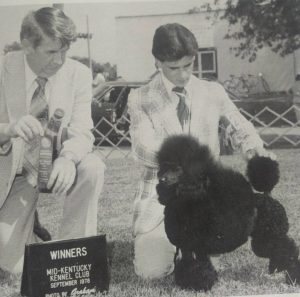 Starting with a toy poodle that he learned to trim by himself at 10 years old, Vergnetti has successfully bred Boxers, Great Danes and American Foxhounds as well. He apprenticed with professional handlers in his teens, including Ted Young Jr, then went to work for Wendell Sammet, Ale Kai poodles.
Starting with a toy poodle that he learned to trim by himself at 10 years old, Vergnetti has successfully bred Boxers, Great Danes and American Foxhounds as well. He apprenticed with professional handlers in his teens, including Ted Young Jr, then went to work for Wendell Sammet, Ale Kai poodles.
“Wendell was hardest worker in the world. Everything was very precise,” Vergnetti said.
It was during this late ‘60s, early ‘70s time frame, that the trimming and presentation style of poodles changed dramatically, Vergnetti said, with the “spray up” becoming more and more important.
“Today it is a little over-done,” Vergnetti said. “They are almost a caricature, way over the top. Hairspray and excessive presentation has taken over. In a way, I think poodles are a victim of their own beauty. There is a normal dog (construction) under all the hair. That’s very important.”
Differences in varieties
Miniature poodles are Vergnetti’s favorite, he said, adding that “Miniatures are smart. They’re the perfect size. They know what they like and what they don’t.” He noted that miniatures often have more work ethic than standards. They were originally truffle dogs and circus dogs. “They don’t take much (grief) from anybody.”
Breeding planning
When breeding dogs, you need to have all ingredients, like a recipe, Vergnetti opined. The Dassin program generally maintains seven or eight stud dogs and an average of 10 bitches… “It’s important to have the dogs you want in front of you,” he said.
The Dassin Farms facility features a four-story-tall barn for a kennel building, Vergnetti said, with 50-60 runs and 72 windows all around.
“We can see the dogs all day, every single day. We take hair off the puppies to see the bodies. You can see temperament. We evaluate them every day on their own,” Vergnetti said, which he adds is how they make decisions about which dogs to keep.
343 — Saturday Symposium – Preservation Breeding With Experts
Saturday Symposium – Preservation Breeding With Experts
Host and Moderator Laura Reeves is joined by breeders/judges Lesley Hiltz, Sid Marx and Karen Ericson at the Whidbey Island Kennel Club with a robust conversation about preservation breeding. This is part one. Part two, including audience participation, conversation and more idea generation will be posted next Monday.
Preservation of our breeds to save their place in history

Lesley Hiltz
“When you judge in Europe,” Hiltz noted, “the average exhibitor age is mid 30s. There are lots of families, often three generations together. It’s a family sport. But they also only have one show a month. If we had fewer shows we could see more support for the ones remaining.”
Marx observed that too often exhibitors haven’t even read the standard for their breed.
“People become captive to what’s winning. Breeding to what’s winning rather than what’s correct. We want to get as many new young exhibitors involved in the sport as we can. But they need to make an effort to find mentors and learn the history of their breed,” Marx said.

Sid Marx
Ericson encouraged folks to “Get our dogs out among the public.” Clubs need to do things besides dog shows, she added.
“To get a dog from a breeder, you might as well apply to be a CEO of a fortune 500 company,” Erickson said. “Trust people with your best, not your worst. Tell them you are trusting them with a piece of my heart and legacy.”
“Dog shows in Australia are less stressful and more fun,” Marx said. “Certainly more wine is drunk. It’s a party at their shows. It’s an event.”
Proactive policies

Karen Ericson
Some ideas from the panelists:
- Encourage altered dog competition
- Encourage anyone who shows a spark to come to the dog show. Stop what you’re doing and share with public. Share excitement about the show.
- Bring back dog shows that stop at the breed level. Rankings are hurting us. The average person isn’t at the dog show to fight for Group 1.
- Follow Austalia’s lead: “class in group awards.” So if your 6-9 puppy wins his class, he competes in 6-9 competition in group. People stay for group, talk to other people in other breeds. Gives a whole lot of other people the chance to win something in group.
To hear previous discussions on this topic, click here and here
330 – Breeding Rules from John Buddie, Tartanside Collies
Breeding Rules from John Buddie, Tartanside Collies
John Buddie has spent a lifetime with Collies. His Tartanside family of dogs is world-famous and widely respected. His Breeding Rules are a distillation of more than 50 years of experience and success. This is part one of a two-part series.
Buddie’s original breed mentor gave him much of the knowledge he continues to share today.
“This was mentorship in the days of letter writing, plus weekends spent doing kennel chores, brushing dogs, really hands on work,” Buddie said. “When I asked a question, she would ask me a question to make me think.”
Spoon-feeding someone an answer doesn’t have the same impact as helping someone come to their own conclusion, Buddie observed.
Buddie’s “rules” are guidelines that are applicable across breeds and generations.
*Leave the sport/breed no worse than you found it
Show respect for the lines and breeders who came before by preserving that quality.
*The number of champions finished/ribbons earned is not the measure of a breeder
“There have been many important contributing breeders who changed the face of a breed who bred on a small scale,” Buddie said. “For every record achieved there will always be someone who can break that record.”
*Learn to read a pedigree
Research, look to breeders of the past, learn what they accomplished and how.
*Look to the grandparents
Most top producing dogs are just carrying the pedigree forward. Top sires, often the strength comes from dam side.
“I’ve had great success using the Maternal grandsire effect, in other words breed a quality bitch to her maternal grandsire,” Buddie said.
*You can never outrun a problem
“It’s a lot easier to rid yourself of problems with testing now. But you have to admit the problem and deal with it. It can mean scrapping a couple generations of breedings to clear it out. But you have to protect your breeding program as a whole.”
*Learn to see quality in other people’s dogs
“We make evaluations of dogs when we’re competitors… when you’re judging you realize you weren’t as open-minded as you thought you were.”
*Attend national to see dogs that you wouldn’t see any other time
Join us next week for the continuation of this fabulous conversation.
168 – Breeder Education Advocate Claudia Orlandi Shares Knowledge
CLAUDIA ORLANDI ON EDUCATION AND DOG BREEDING
AN EARLY “EYE FOR A DOG”
Orlandi grew up with miniature and standard Poodles, but her first show dog was a Saint Bernard from Betty Roberts. When her family visited the breeder to pick a puppy, somehow the divider between the “show” dogs and the “pet” dogs had fallen down. With an “eye for a dog” at even an early age, the puppy her family chose led Orlandi into a life of dog shows. Eventually, shown by Bob Forsyth, that Saint Bernard became a Best in Show Winner.
“…structure and performance or, form following function, are the key characteristics of breed type and are what distinguish one breed from another.”
Horses and dogs were a passion she shared with her first husband, Dom. They acquired their first Basset Hound from a pack in Vermont. There they learned the functional aspect of their hound by following the pack on rabbit hunts. Orlandi now lives part-time in Spain, where she had just returned from a month of hunting with her hounds when we spoke for this interview.
“… I have to say that having had the experience of hunting with Emma (her first Basset) was a great starting point for really understanding the basset hound breed,” Orlandi said. “…structure and performance or, form following function, are the key characteristics of breed type and are what distinguish one breed from another.”
Orlandi attributes much of her knowledge of anatomy and animal husbandry to the 4-H program. In her shout out to the horse 4-H program she noted, “We had to pass difficult written and hands on tests on equine anatomy and movement, in addition to giving presentations and learning animal husbandry. All of this knowledge relating to horses, I was easily able to apply to breeding and showing dogs.”
But as she progressed in her breeding program, she came to understand that other breeders didn’t have the same good fortune.
“If we to learn about photography we can go to photography school,” Orlandi said. “If you want to become better cooks, we can take cooking classes. But at that time, we really didn’t have anything comparable if we wanted to learn to become better breeders.”
Knowledge is power, Orlandi noted, in everything that we do. So, she began to develop her education programs and books, including the fabulous Basset Hound University program she created and has shared with other Parent Clubs. She insists that breeders can be successful with some basic information to help them move forward.
Some of her best recommendations?
- …the concept of preservation breeding is an extremely important topic that deserves our ongoing support and attention.
- …one of the biggest myths is the belief that because breeding revolves around chance and randomness applying genetic principles won’t make a difference. Nothing could be farther from the truth. In reality, it’s very unlikely that a breeder can consistently produce healthy, quality dogs in which every generation the dogs are better than they were in the previous generations, without understanding how traits are passed from one generation to the next.
- …don’t purchase a bitch younger than 12 to 18 months. If you get a bitch much younger than this, they have not been able to do enough health tests and body structure might still be developing.
- …I think it’s really difficult, in a way, to find a good person to work with in a breeding program or to find a mentor. Because in a way it’s kind of like a marriage. I think you have to be psychologically compatible and you have to have a lot of the same goals and the same beliefs in common.
- … a few decades ago if people were honest about health problems they are absolutely shunned, many times, by their peers. Talking about health was considered taboo. Nowadays, we understand much more about controlling canine genetic disease and we know that if we’re honest about the health problems, about who the affected dogs are in our pedigrees we can control health problems in our breeding program very, very easily. But it all revolves around being honest.
Please enjoy my visit with this legendary advocate for breeder education in purebred dogs.

